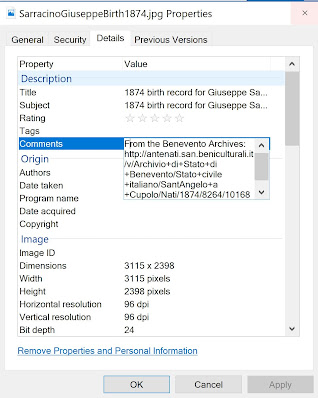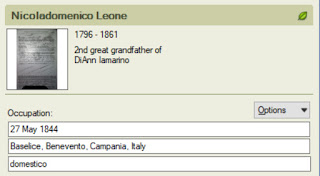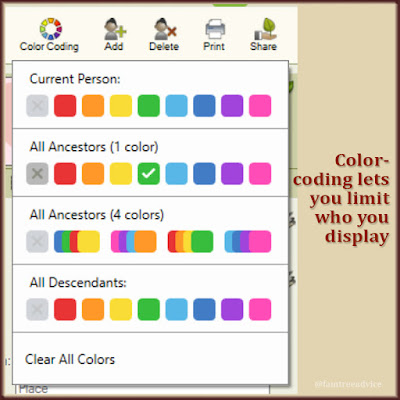I'm working on the ultimate database of my ancestral hometowns in the 19th century. I'm typing the important facts into a spreadsheet as I examine:
- birth records
- death records
- marriage records
from all my ancestors' hometowns in Italy. My husband thinks I'm crazy, of course. But every detail fascinates me.
The facts I'm pulling from each vital record include:
- names
- dates
- occupations
- ages
- addresses
 |
| A family's address in an 1866 Italian birth record. The village is seen after the father's name. The street is seen after the mother's name. |
The beauty of the spreadsheet is this:
When I discover a new relative, I can search the spreadsheet to see if I've already got his siblings or his parents. If I do, I can piece together more about this family.
 |
| Neighborhood names are seen in larger text. |
I can spot some patterns, too. I've noticed that many of my closer ancestors will have the same address.
In 19th century rural Italy, these are not street addresses and house numbers like we know today. They are sections, neighborhoods, clusters of houses. You can imagine that in more modern times, mail delivery made it necessary to have house numbers. But when my ancestors lived there, family members built their homes next to one another. As time went by, children grew up and married, and they built more houses near their relatives.
These neighborhoods may have changed names over the years. Some of the rural sections may not be quite as rural as they were. Tempi cambi—times change.
If you are taking note of the place where your ancestor lived, you may not be able to find it on a map today. But it's still helpful to compare the addresses of different family members. Let's say one family lived in Neighborhood A, and another in Neighboorhood B. If the families intermarried, where did they live?
Here's a very helpful website that explains the
different Italian street types. I found out many of my ancestors' addresses were like township or hamlet names in America.
In fact, my mom's ancestors come from a township called Pastene. That's the name of the place my grandmother and great aunt often said their parents came from.
But when their parents and grandparents came to America, they said they were from Sant'Angelo a Cupolo. It turns out that Pastene is a township of Sant'Angelo a Cupolo.
So, how can you figure out where on the map your ancestors lived?
On Google Maps or Bing Maps, you may not get a lot of detail for your European ancestral hometown. You can zoom all the way in, and you can see how it looks when you're driving down the street. But you can't see the names of the tiniest outlying streets.
So look for the neighborhood names—those clusters where extended families used to live. When I look at the map of Pastene, the bigger names surrounding it are villages. I recognize these names from my 19th century documents. Perrillo, Panelli, Montorsi, Maccoli, Motta.
Having a map of the town open while you try to read the place name on an 1850 birth certificate can come in handy.
You may not be able to pinpoint your ancestor's home, but finding their neighborhood is something to celebrate.
 |
The TomTom app shows
more street names. |
Here's a tip for anyone who uses a GPS and has access to international maps. You can see more street names with your GPS than on Bing or Google.
My GPS is a TomTom, and I have their app on my smartphone. When I search for Pastene in the app, I can zoom in and see more street names. Its search function is very smart, and can help you find the area you want.
If you can find an
online phone directory for the country you want, you may be able to search for an address. For example, on the
Italian White Pages site, I can choose to search by address. The form asks me to provide a locality (town), address and number. I entered an address from an 1866 birth record: Sant'Angelo a Cupolo, Contrada Lesi. As I typed, the website gave me the closest match: Via Lesi.
And OMG, of the four families living on that street, one has the same last name as my grandmother: Sarracino!
 |
| An online phone directory finds the new street name. |
Whichever country and town you're researching, use everything you can to do pinpoint your ancestors:
- online maps
- GPS maps
- online searches, particularly Google and Wikipedia
- online phone directories
Putting pins on a map, even if they mark a neighborhood and not a house, can help you understand where your roots lie.
 At last you find what you want: the marriage record for your 2nd great grandparents. Eureka! Now you can learn the names of two sets of your 3rd great grandparents.
At last you find what you want: the marriage record for your 2nd great grandparents. Eureka! Now you can learn the names of two sets of your 3rd great grandparents.

















